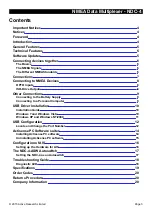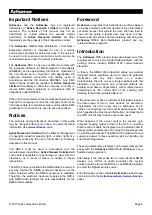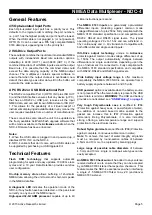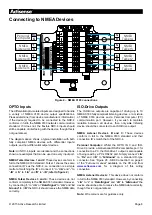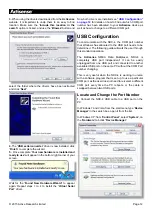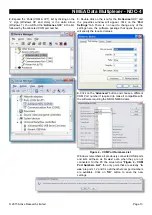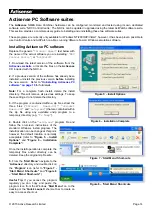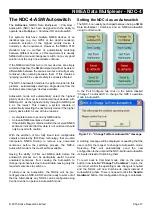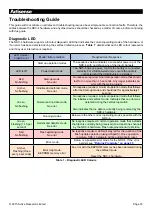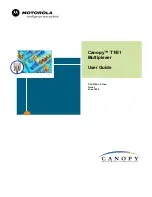
NMEA Data Multiplexer - NDC-4
Page 5
© 2015 Active Research Limited
General Features
4/5 Opto-isolated Input Ports
Each Opto-isolated input port has a priority level. This
defaults to the logical order matching the port numbers,
i.e. port 1 has the highest priority and port 4 has the lowest.
When the USB cable is not plugged in (or not powered),
OPTO IN 0 can be used as a fifth fully compliant NMEA
0183 data input, appearing last in the priority list.
2 ISO-Drive Output Ports
These outputs combine the input data into standard NMEA
outputs with independent Baud rate selection options,
defaulting to 4800 (OUT 1) and 38400 (OUT 0). If the
combined Baud rate of all NMEA inputs exceed the output
Baud rate, it is possible that the combined data could
exceed the data carrying capacity of the NMEA output
channel. The multiplexer contains special software to
ensure that when the output channel is overloaded, new
data of the same type as older data, still in the buffer, will
overwrite the older sentence.
A PC RS232 or USB Bidirectional Port
The RS232 compatible Port 0 (OPTO IN 0 plus ISO OUT
0) and the USB interface ensures that any device (or PC),
that has an RS232 or USB port, receives all the input
NMEA data, and can add its own NMEA data to ISO OUT
1. This allows for the possibility of a “virtual cockpit” of
instruments displaying all available data in any manner the
user requires (available from a number of manufacturers).
These connections also allow the unit to be updated via
the freely available ActiPatch flash upgrade software that
will be made available on the
Actisense
website when the
NDC-4 firmware has been enhanced.
Notes:
1.
When the USB cable is plugged in and powered up, it
disables OPTO IN 0 on the NDC-4.
2.
NDC-4 variants that don’t come with a USB cable can
be upgraded by purchasing a USB Upgrade Kit.
Technical Features
Flash ROM technology
that supports automatic
programming for quick and easy updates, 100,000+ erase
cycles and a 10 year Data Retention provides carefree
user configuration.
On-chip memory store
allows buffering of short-term
NMEA data, allowing the unit to smooth short-term peaks
in the NMEA data flow.
A diagnostic LED
indicates the operation mode of the
NDC-4, if any faults have been detected, or the peak load
currently on any one of the NMEA inputs.
High-speed 32-bit ARM processor
capable of up to 40
million instructions per second.
The NMEA 0183 inputs
are galvanically opto-isolated
differential inputs, protecting against common mode
voltage differences of up to 2500v. Fully compliant with the
NMEA 0183 standard specification and compatible with
RS232, RS422 and RS485 signal levels. The typical
operating voltage is 2.0v to 15.0v and can wit/-
35v continuously and +/- 40v transients. Compatible with
both differential and single ended inputs.
ISO-Drive output technology
unique to
Actisense
,
protects against common mode voltage differences of up
to 1500v. The output automatically changes between
differential and single ended drive depending upon the
type of instrument it is connected to. Fully compliant with
the NMEA 0183 standard specification and compatible
with RS232, RS422 and RS485 signal levels.
Wide battery input voltage range
to offer maximum
compatibility, the NMEA 0183 NDC-4 can operate from a
battery supply anywhere between 8 and 35 volts.
USB powered
option is available when the battery source
is not present. When the main battery is present, the USB
power drain is minimal.
WARNING:
The USB and battery
grounds are not isolated, see
Very tough Polycarbonate case
is certified to IP66
(Protection against heavy seas, or powerful jets of water),
the addition of non-acid based marine sealant to the
gasket can increase this to IP67 (Protection against
immersion). Being Polycarbonate, it is also incredibly
strong, offering a wide temperature range and superior
protection to the electronics inside.
Robust Nylon grommets
are certified to IP68 (Protection
against complete, continuous submersion in water).
Note:
To achieve this level of water integrity all glands
must be occupied by round-section cables of between
4.5mm and 10 mm or be replaced by blanking plugs.
Large range of possible cable diameters
of between
4.5 mm and 10 mm, single or multi-pair wire types can be
easily accepted.
An NMEA 0183 Checksum
will be added to any sentence
received without one to ensure that they can be accepted
by an NMEA 0183 Listener that expects a checksum. This
feature makes the NDC-4 essential even when interfacing
a single v.1.5 NMEA 0183 Talker to a v.2.0 (and above)
NMEA 0183 Listener.
Summary of Contents for NDC-4
Page 2: ......



